What Is Mange in Cats?
“Mange” is a general term that means an infectious skin disease characterized by intense itching, reddened skin, and alopecia (loss of hair), caused by parasitic mites. While mange is a type of dermatitis (i.e. inflammation of the skin), it is specific in that the underlying cause is specifically identified as infestation with a mange mite.
Many other types of skin disease may resemble mange (i.e. the skin appears reddened, with hair loss) but they require a different diagnostic approach and treatment.
Quick Overview: Mange in Cats
Causes of Mange in Cats
Mange is caused by various types of parasitic mites, including Notoedres cati, Demodex mites, and Sarcoptes scabiei var canis.
There are three parasitic mites that cause different types of mange in cats.
1. Notoedric Mange
Sometimes called “feline scabies”, this is the most common type of mange seen in cats. The condition is caused by a mite called Notoedres cati, which is invisible to the naked eye, measuring 200-250µm in diameter (this is 0.2 to 0.25mm: around the size of a pinprick).
Under the microscope, the mite can be seen as a tiny, oval, white bug with three pairs of short legs on the larvae, and four pairs on the nymph and adult stages. The mite is contagious, spreading from cat to cat by direct contact, causing extreme itchiness as the mites burrow into the skin.
The adult female mites lay the eggs deep in the skin, and after they hatch, the larvae move to the surface of the skin, where they develop into the nymph stage before transforming into adults. All stages of the mite feed on the skin, causing itchiness due to the damage from feeding. The complete life cycle from egg to adult takes three weeks.
Notoedric mange is seen most commonly in cats with a poorer immune system (e.g. kittens). This type of mange is rare in cats: it’s seen in less than 0.1% of cats with skin conditions in the USA and has not been diagnosed in the UK at all for over fifty years.
2. Demodectic Mange
Demodex mites are seen in many mammals (including cats, dogs and humans). They start off as normal, harmless, commensal parasites, living in hair follicles, sebaceous glands, and the superficial layers of the skin.
It’s only when there is some sort of immunodeficiency in the host that the mites start to multiply in large numbers causing skin disease. Demodex mites are cigar shaped, only visible under the microscope, measuring around 350µm or 0.35mm long.
The eggs are also elongated ovals; these hatch into six-legged larvae, which become eight-legged nymphs and then eight-legged adults. Demodectic mange is rare in cats, accounting for less than 0.04% of cases of skin disease in the USA.
3. Sarcoptic Mange
Sarcoptic mange is caused by a mite that normally lives on dogs: Sarcoptes scabiei var canis. This mite is only seen exceptionally rarely in cats, on occasions when they have had close contact with infected dogs or foxes. These mites are small, circular, white mites, slightly larger than Notoedres mites at 300-400µm in diameter (0.3-0.4mm). Again, the larvae have three pairs of legs, while the adult mites have four pairs.
Other external parasites, including ear mites (otodectes cynotis) and walking dandruff (cheyletiella) may resemble these mange mites under the microscope, but they cause a different pattern of ear or skin disease, and are not generally classified as “mange”.
Ringworm may cause balding, reddened areas that resemble mange, but this is caused by a type of fungal infection, so it requires a completely different approach.
Symptoms of Mange in Cats
Itchiness is the primary symptom of mange in cats, along with skin redness, hair loss, dandruff, and more. Symptoms may also vary depending on the type and cause of the mange.
Mange, by definition, causes pruritus (itchiness), with reddened skin and loss of hair in affected areas. Often there is dandruff-like scaling, with crusty build-ups on the cat’s skin. The different mites cause a different pattern of location of affected skin.
- Notoedric mange tends to affect the ears, neck and forelegs.
- Demodectic mange (also known as demodicosis) can be generalised (all over the body) or localised (e.g. around the eyes, head, muzzle or neck with one type of mite, Demodex cati, or along the back, abdomen or limbs with the other type, Demodex gatoi).
- Sarcoptic mange tends to be more generalised, affecting the feet, the sides of the body, the back legs, the face, the ear tips, and the tail
Diagnosis of Mange in Cats
If your cat shows signs of mange, you need to visit your local DVM veterinarian. A sample needs to be collected from the cat (usually a skin scraping, but sometimes an acetate tape impression from the coat can be sufficient to identify Notoedres or Demodex mites).
Examination of the sample under the microscope is always needed to positively identify the causative mite.
Treatment of Mange in Cats
Treatment depends on the type of mite infestation, and the appropriate medication will be prescribed by your veterinarian.
Treatment options include:
- Selamectin as a spot-on topical treatment (a product that owners may be familiar with as a preventive treatment for fleas and heartworm)
- Milbemycin oxime as an oral medication
- Doramectin as a once weekly injection
- Lime sulfur dip as a topical therapy
- Ivermectin as an oral or injectable medication
- Amitraz as a once weekly dip, allowed to dry on the cat without rinsing.
- Moxidectin/imidacloprid (Advocate) as a spot-on topical preparation
- Fluralaner (Bravecto) as an oral medication
- A combination product of fipronil 8.3%, (S)-methoprene 10%, eprinomectin 0.4%, and praziquantel 8.3% (Broadline)
The initial mange problem may be complicated by secondary bacterial infection of the itchy skin, so antibiotics and other treatments for skin infections may also be needed.
All of these products have the potential to be toxic if used incorrectly, so they must only be administered following veterinary prescription and guidance as part of a broad, specific treatment plan.
Frequently Asked Questions
Does apple cider vinegar kill mange?
Despite advice from some websites, apple cider vinegar is unlikely to cure mange in cats on its own, and it’s far more efficacious to use proper miticidal therapy as prescribed by your veterinarian.
Is mange in cats contagious to humans?
Notoedric and demodectic mites are species-specific, so cannot infect humans, while sarcoptic mites may transiently infect humans.
How can I treat my cat for mange at home?
There is no effective home treatment for mange in cats: the only way to effectively resolve this rare problem is to use prescription-only products provided by your veterinarian.
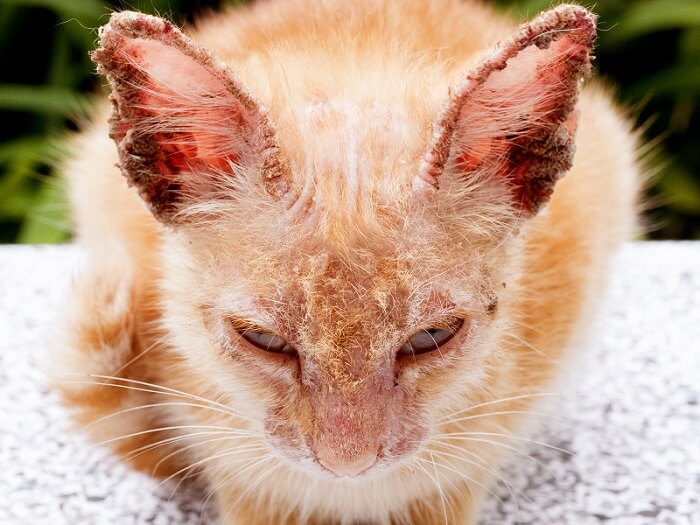
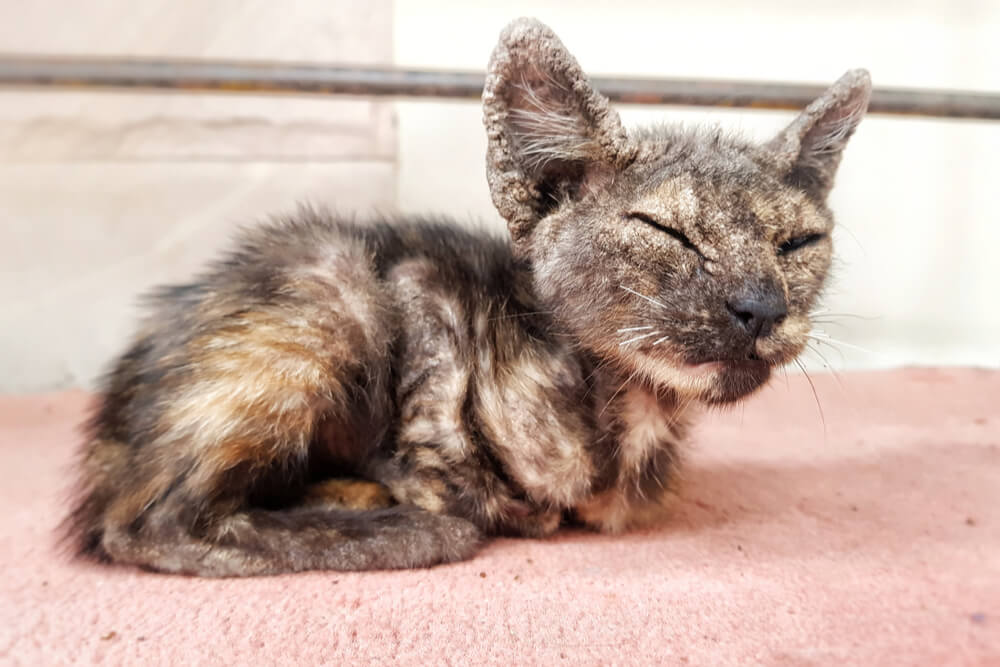
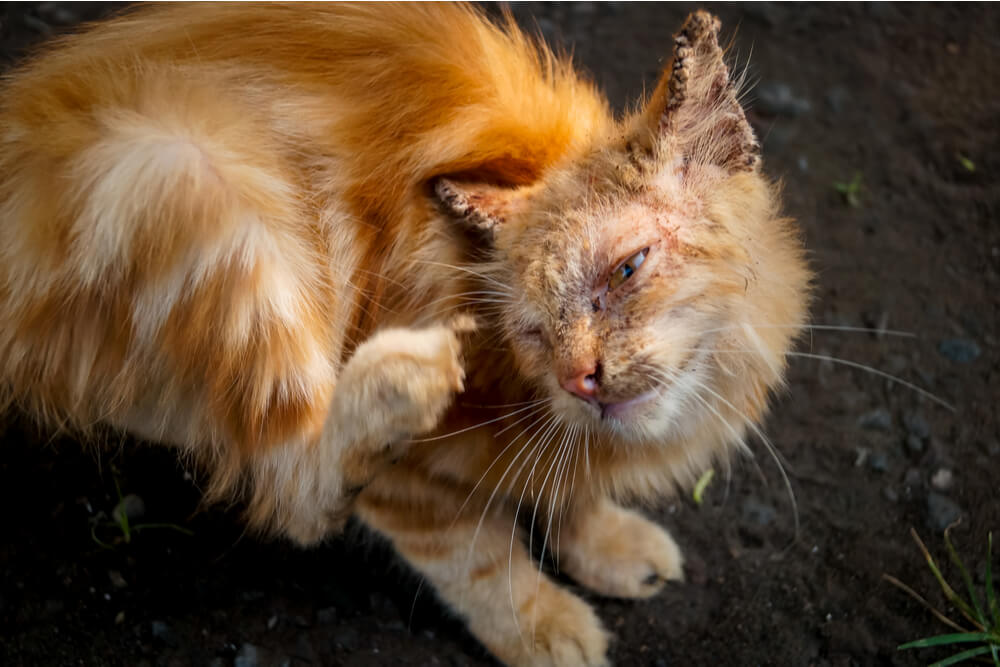



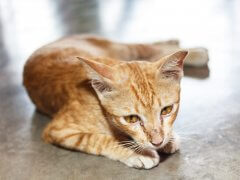


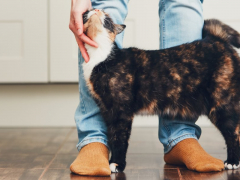

I have a beautiful feral cat that has been coming to my door every day for 8 (yes, eight) years. Won’t let me anywhere near him though. He’s a tuxedo cat whose black coat has areas of what looks like discolored fur. His little white chest has some areas of missing fur and he looks a bit “rheumy”. Hasn’t hurt his appetite at all so I am wondering if there’s anything I could put in his food to help his mangy looking skin? He’s been trapped before & had been neutered so I can’t blame him for his trust issues! Still, he’s been such a faithful beggar for all these years, I would like to be of some help to him.
Hi Rosemary, that’s a wonderful question. There are so many things that could be causing this cat’s discolored and patchy fur…parasites, overgrooming, or some other condition. You may be able to improve his skin condition with salmon oil or another fish oil in his food, but other than that, I don’t have any general advice for this type of discoloration and patchiness. The All About Cats community forum may be able to help you further.
I have a 3 yr old Calico who has a rash that developed about 2 months ago. I been watching it and it has progressively gotten worse. It’s now much redder and has spread in size. She bites at it but it’s on the inside of her back leg so not able to scratch it. I feel so bad that I am unsure what I can do to help her. I know it is uncomfortable for her. She does not go outside nor has she given it to my other cat. That tells me it must not be contagious. I just an trying to find something topical that I can put on it that if she was to lick it wont hurt her. She is the worse to try n take to vet. She get so freaked out. Just trying to help give her relief. Any suggestions is greatly appreciated. Thanks and Can contact me at 941 248 2297. Thanks again in advance for any advice
Hello Crystal, apologies for the late reply! Unfortunately, we can’t give you advice, especially without being able to see your cat. I would encourage you to look into veterinary telehealth or a home visit with a veterinarian. Wishing you and your calico all the best.
A 3 yr old Calico with a rash that has progressively gotten so much worse. I can attach pics if necessary. She is not east to get to vet and It turns into a huge ordeal. I am looking for what kind of med I can buy and try prior to going to vet. They are indoor cats so I’m unsure what it could be caused by. Anyways any advice is greatly appreciated. Thanks so much
ps. my other cat has nothing so cant be contagious. I’m just at a loss as to what can do to help her.
Hello Crystal, again, we’re unable to give medical advice through this platform. I would strongly encourage you to send photos to a veterinarian via a veterinary telehealth platform. A few options include WhiskerDocs and Chewy’s Ask a Vet service for Autoship customers. This article provides a lot of details on some of the top options available.
I just moved to a new house and i have a feral cat that comes around all the time, I’ve been feeding him, he’s super skinny and pretty sure he has mange, ear mites and worms. I can’t catch him I’m pretty sure he’s been beat up by other cat’s and humans, he’s been trusting me a little more each week, how can I treat him ? I really feel sorry for the guy and I’m sure he would make a great pet if I can get to that point. I just want to help him.
This is difficult, as it really is impossible to give him the care he needs without physically examining him. I would suggest the best thing is to first of all give him a good broad spectrum worm dose in his food, as that is easy to do. Continue to tame him with food, several times a day. Then in a month or so, you should be able to handle him a bit, and you could then apply a good spot-on product (one that treats for fleas and lice and mange) – ask your vet to suggest one. Then as time passes, you should be able to tame him enough to take him to the vet, and the rest of his issues can be looked at (castration, microchipping, vaccination). The only alternative would be to trap him to do all this at once, and he would be so terrified that it would upset your taming process and be highly stressful for everyone. So go for the slowly, slowly approach, and keep us posted!
Thank you, I will keep you posted on my progress
Hello Dr. Wedderburn, I feed some homeless cats near my work and one began to get a bunch of bald spots on it and now it is happening to another. Would this be mange? Can it be deadly to them or just terrible looking. Not sure how I can help them but two out of the seven now have it. They still eat good and are very happy to see me also rubbing up on me. Hopefully I can’t transport it to my own cats at home.
Hi Denise – well, this could be mange, it could be fleas, or it could even be ringworm. None of these are fatal, but they certainly can cause discomfort, especially if they get worse. It’s very difficult to diagnose and treat feral cats – they would need to be trapped, examined and injected, and that is a big deal. It’s probably best just to continue to monitor the situation, but just be aware that fleas and ringworm especially could theoretically be passed via your clothing/hands to your own cats, so just remember to wash your hands thoroughly after any physical contact with them, and change your clothes if they have been rubbing up against your clothes.
I hope this helps. Pete
Can I spray the affected areas with Apple Cider Vinegar?
Vinegar would not be a good idea at all: this is acidic, and might further irritate the affected areas of skin. Something soothing, like a little coconut oil, is far more likely to help, but better again, affected cats should be taken to the veterinarian, as the ultimate answer is to make a diagnosis of the primary underlying cause, and then to give specific treatment.
Hi! my cat has been receiving topical treatment for mange and her fur is greasy because of it, her meow is also weaker compared to normal, but she is strong and playful. any tips?
Hi Karla. It’s common for fur to be temporarily greasy following some types of treatment for mange, and this should pass once the treatment finishes. The treatment should not affect her meow, so this is probably not connected. There are many possible reasons for a weaker meow. In general, I would monitor for a couple of weeks if that is the only sign of unwellness, as sometimes it can be caused by a minor issue that will resolve on its own (such as an allergic reaction, a mild viral infection etc). If it carries on for longer than that, then it’s best to take her to your vet for a full checkup.